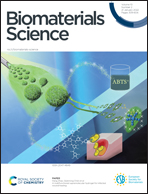A confined crosslinking strategy towards an intelligent organosilica–micellar hybrid drug delivery system†
Abstract
An ideal drug delivery system must have a high level of stability to ensure effective circulation and passive aggregation, good retention performance, and dynamic delivery and treatment monitoring. Thus, the development of a smart drug delivery carrier with both precise drug release and real-time detection remains a challenge. Herein, we propose a confined crosslink protocol to prepare an intelligent hybrid delivery system for auto-fluorescent monitoring, protonation-induced retention and precise drug release. The construction of this system involves the hydrolysis and condensation of (3-aminopropyl)triethoxysilane (APTES) silanes inside the Pluronic polymer micelles and thereafter a confined Schiff base crosslinking between glutaraldehyde (GA) and residual silane amino groups. The size of the intelligent docetaxel (DTX)-loaded nanosystem changes from ∼25 nm in blood circulation or normal tissues (pH ∼ 7.4) to ∼250 nm in slightly acidic environments (pH ∼ 6.5–7.0) owing to intra-molecular hydrogen bond-induced aggregation and imine cleavage-induced disintegration in the endosome (pH ∼ 5.0–6.2) along with auto-fluorescent monitoring contributing to the high-efficiency chemotherapy. This work provides a new method to construct smart, acid-responsive and fluorescent-guided drug-delivery carrier systems for efficient and safe tumor chemotherapy.



 Please wait while we load your content...
Please wait while we load your content...